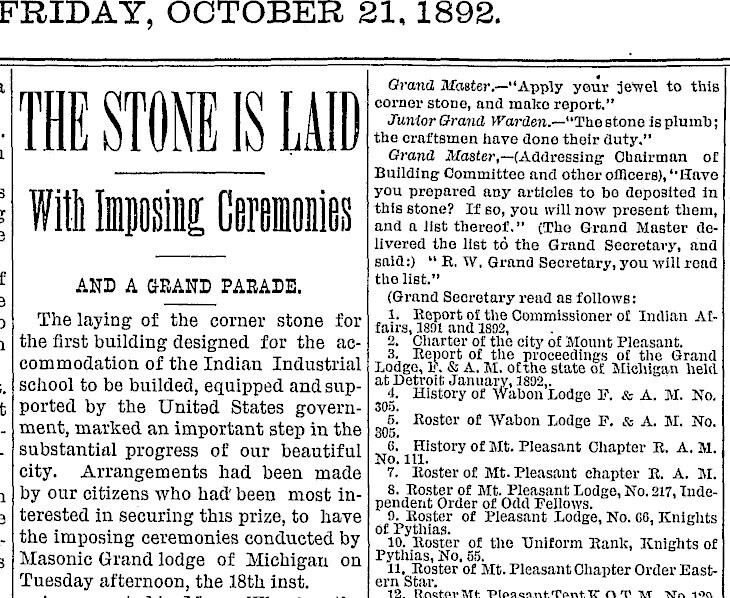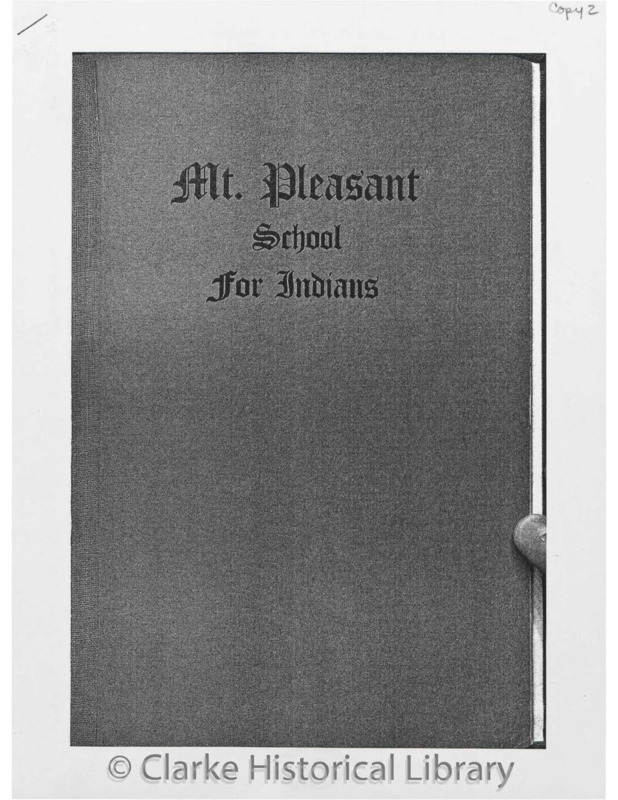Mt. Pleasant Indian Industrial Boarding School
Mount Pleasant Indian Industrial Boarding School in Mount Pleasant, Michigan was the third boarding school in the state, opening officially in the 1890s. The development of Indian Industrial, as it was called in the local news, was celebrated by the non-Indian community. Its establishment was done by an act of Congress in 1891 (Saginaw Chippewa Indian Tribe of Michigan, 2018, para. 6). News reports from the era kept residents informed about the progress of Indian Industrial Boarding School, arguing that it was for the benefit of the Indian community.* Once construction began with laying the first stone, Mount Pleasant officials held a parade and invited the local masonic organization to conduct a ceremony, detailing the events in the local newspaper, Isabella County Enterprise, with a lengthy, multi-page news article “The Stone is Laid: With Imposing Ceremonies: And a Grand Parade” (Isabella County Enterprise, 1892, pp.1, 5, 8). At no time were Native American members of the community invited to participate in the ceremony.
Eventually Indian Industrial comprised about a dozen buildings over 320 acres and taught three-hundred students annually (Stebbins, 2021, para. 32). Students were forced from all over Michigan and other states to live at Indian Industrial during this time (Graham, 2021, para. 2). In addition, their ages varied. Official historic records state that the children were between 5-14, but photographs show that some may have been younger or older than this official range (Walker, 2021, para. 40). Like other schools, children were forced to assimilate and thus, unable to express their identity and culture. They could not wear tribal clothing, have tribal hairstyles, and instead were required to wear uniforms and have “white” haircuts. Nor could they speak their language.
For breaking the rules, children were harshly punished. There were multiple deaths recorded at the school; the true number is in dispute as official documents only record five deaths, contrary to the knowledge of local tribe members and researchers who state that there were over two-hundred deaths at Indian Industrial (Stebbins, 2021 para. 31; Walker, 2021, para. 39). Conditions were harsh in other ways, overcrowding and unsanitary conditions led to outbreaks of diseases such as smallpox, and students had small food rations (Walker, 2021, para. 41).
While these abuses were occurring, officials behind Indian Industrial promoted the school as a place for Native Americans to prepare them for the “Duties, Privileges, and Responsibilities of American citizenship” (Mt. Pleasant School for Indians, p. 3) in a pamphlet from 1913. Within the pamphlet, Mt. Pleasant School for Indians, they included descriptions and photographs of the building facilities and grounds, as well as their classes and activities that were designed to make Native Americans more “American.” These included classes such as Domestic Science for female students and sports teams including baseball and football.
Around the same time period as the pamphlet’s publication, school officials corresponded to the federal government’s request for information on Indian Industrial including its industries, purchases, population, etc. Each year, officials from the school sent updates on the school to the Commissioner of Indian Affairs in their Annual Reports such as the one below. These detail industries, such as education, as well as important data including student enrollment, employees, and other activities relating to music, athletics, and farming. However, the school portrayed them in a positive light, in comparison to testimonies from survivors after the school’s closure.
Significant to the report are details each year about the various illnesses occurring at the school. Although officials describe the health conditions as “excellent” and “sanitary” each year, details such as overcrowding, quarantines from epidemics and illnesses, and reports of four deaths (Annual Reports 1910-1913, pp. 36-37) paint a different story. In addition, the language used to describe students and the broader indigenous communities reflect broader societal trends at the time. For example, throughout the report, indigenous communities are broadly described as “the Indian” and those that do not live “modern” lives such as farming and living cities are seen as lacking “progressiveness” (Annual Reports 1910-1913, p. 26).
Unlike other Michigan boarding schools, Indian Industrial was open for a shorter period and has parts of the physical site remaining. As a boarding school, it ended in 1934, but remained opened until 2009 as a home and training institute for those with disabilities. After this closure, the Saginaw Chippewa signed an agreement with the federal government to purchase the land and remaining structures as an effort to remember and heal (Native News Online Staff, 2021, paras. 1-8; Saginaw Chippewa Indian Tribe of Michigan, 2018, paras. 1-7).


